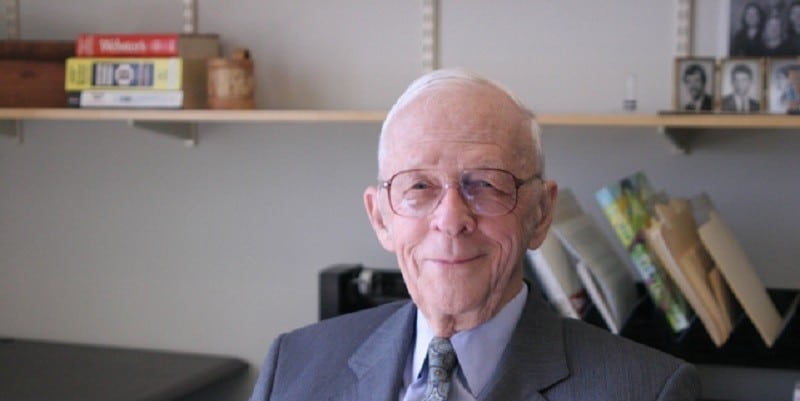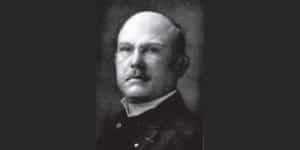Jay Forrester

Jay Forrester (Jay Wright Forrester; 14 July 1918 – 16 November 2016) was a pioneer in digital computer development, author, and lecturer. He is better known for concepts such as system dynamics and magnetic core memory. His contributions to the field of computer engineering have numerous times been awarded.
Biography
Jay Forrester was born on a cattle ranch in Nebraska, a county in the United States. Both his parents are graduates, and he grew up with his sister Barbara Francis who was born three years later after the birth of Jay Forrester. Both his parents were teachers, which was beneficial for him because during the first years of schooling he was educated by his parents.
Since Jay Forrester grew up on a ranch, he had to find innovative ways to spend the day. He rides horses from a young age, but next to this, Jay became interested in electricity. For example, after his class, Jay Forrester played with batteries and telegraphs. In addition to his interests, he spent time attempting to create practical innovative solutions. As a result of his proactive attitudes and initiatives, Jay Forrester created a wind-powered generator to supply energy to the ranch.
Jay Forrester studied electrical engineering at Nebraska University. He graduated in 1939 with both engineering knowledge as hands-on experience. After his graduation, Jay Forrester began his professional career at MIT, Massachusetts Institute of Technology, where Jay Forrester worked as a research assistant. During this time, he worked with high voltage electrostatic generators, and he had the opportunity to collaborate with Gordon Stanley Brown, known for automatic-feedback control systems and the numerical control of machine tools.
At the same time, Jay Forrester was studying for his MSc in electrical engineering at MIT. In 1945, by the time of graduation, Jay Forrester already worked on different types of electrical products such as feedback control systems and servo-control systems. These were additionally used in the American army.
During his time at MIT, more specifically from 1940 until 1951, Jay Forrester first worked as an Associate Director of MIT’s Servomechanism Laboratory, which he also co-founded. He next worked as the Head of the Digital Computer Division in MIT’s Lincoln Laboratory from 1951 until 1956. In this position, Jay Forrester attempted to develop flight simulators but soon find that the computers at that time did not meet the requirements to design a simulator. They were still too slow. This was the primary trigger for Jay Forrester to create a magnetic core memory, which was a significant innovation in the computer technology industry. He was later awarded a Medal of Honor by the IEEE, Institute of Electrical and Electronics Engineers, in 1979.
Jay Forrester was known for his significant contributions in a short time frame, especially between 1940 and 1955. He was known for the quality and reliability that he delivered in the field of system dynamics, business, and public policy. His contributions were the starting point for future technologies.
As of 1956, Jay Forrester joined the MIT Sloan faculty. From this time, he began thinking about industrial dynamics. Based on various conversations with executives at the General Electric Corporation, Jay Forrester identified how systems in the distribution channels were disturbed, which caused inaccurate fluctuations in the number of products that should be ordered, also referred to as the bullwhip effect. Jay Forrester later found that feedback control can be used to better understand management and human systems, which he called industrial dynamics.
Jay Forrester next continued his research together with selected MIT undergraduates in an attempt to further improve his theory on industrial dynamics. His findings on systems, feedback, control, and dynamics are in detail described in his book ‘Industrial Dynamics.’ A year later, Jay Forrester was awarded the Academy Management Award, an award provided to members and others in recognition of outstanding contributions, professional accomplishments, and distinguished service by Academy of Management.
He was additionally awarded many other awards. Jay Forrester’s awards include but are not limited to the Howard N. Potts Medal provided by The Franklin Institute, the Inventor of the Year award provided by George Washington University, The U.S. National Medal of Technology, and the Pioneer Award provided by IEEE Aerospace and Electronic Systems.
Jay Forrester also received honorary Doctorate of Engineering degrees from Newark College of Engineering, the University of Notre Dame, and the University of Nebraska. He additonally received Doctorate of Science degrees from Union College and Boston College. Other honorary doctorates were provided by the University of Mannheim, State University of New York, and the University of Bergen.
Jay Forrester had a sense of humor. He was talkative and very hospitable. He was a family person who adored his parents. Jay married Susan Swett in 1946, and they have three children who grew up in Massachusetts. His contribution will always be memorized.
Jay Forrester quotes
- “The image of the world around us, which we carry in our head, is just a model. Nobody in his head imagines all the world, government or country. He has only selected concepts, and relationships between them, and uses those to represent the real system”
- “Many of the problems the world faces today are the eventual result of short-term measures taken last century.”
- “I believe babies are born as innovative personalities… But our social processes work to stamp out exploration and questioning.”
- “The principles governing the behavior of systems are not widely understood.”
- “Management is in transition from an art, based only on experience, to a profession, based on an underlying structure of principles and science.”
- “The manager’s task is far more difficult and challenging than the normal tasks of the mathematician, the physicist, or the engineer. In management, many more significant factors must be taken into account. The interrelationships of the factors are more complex. The systems are of greater scope. The nonlinear relationships that control the course of events are more significant. Change is more the essence of the manager’s environment.”
Publications and Books by Jay Forrester et al.
- 2007. System dynamics—the next fifty years. System Dynamics Review: The Journal of the System Dynamics Society, 23(2‐3), 359-370.
- 2003. Dynamic models of economic systems and industrial organizations. System Dynamics Review: The Journal of the System Dynamics Society, 19(4), 329-345.
- 1998. Designing the future. Work presented at Universidad de Sevilla, 15.
- 1997. Industrial dynamics. Journal of the Operational Research Society, 48(10), 1037-1041.
- 1995. The beginning of system dynamics. McKinsey Quarterly, 4-17.
- 1994. Learning through system dynamics as preparation for the 21st century. In Keynote Address for Systems Thinking and Dynamic Modeling Conference for K-12 Education (pp. 27-29). Concord Academy Concord, MA.
- 1994. Modeling for learning organizations. Productivity, Incorporated.
- 1993. System dynamics and the lessons of 35 years. In A systems-based approach to policymaking (pp. 199-240). Springer, Boston, MA.
- 1992. Policies, decisions and information sources for modeling. European Journal of Operational Research, 59(1), 42-63.
- 1987. Nonlinearity in high-order models of social systems. European Journal of Operational Research, 30(2), 104-109.
- 1987. Lessons from system dynamics modeling. System Dynamics Review, 3(2), 136-149.
- 1985. The” model versus a modeling “process. System Dynamics Review, 1(1), 133-134.
- 1981. Innovation and economic change. Futures, 13(4), 323-331.
- 1980. Tests for building confidence in system dynamics models. System dynamics, TIMS studies in management sciences, 14, 209-228.
- 1980. Information sources for modeling the national economy. Journal of the American Statistical Association, 75(371), 555-566.
- 1979. System dynamics-future opportunities. Institute of Technology.
- 1977. Growth cycles. De Economist, 125(4), 525-543.
- 1976. Business structure, economic cycles, and national policy. Futures, 8(3), 195-214.
- 1971. World dynamics. Wright-Allen Press.
- 1971. Counterintuitive behavior of social systems. Technological Forecasting and Social Change, 3, 1-22.
- 1970. Urban dynamics. IMR; Industrial Management Review (pre-1986), 11(3), 67.
- 1968. Market growth as influenced by capital investment. Industrial Management Review.
- 1968. Industrial dynamics—after the first decade. Management Science, 14(7), 398-415.
- 1965. A new corporate design. IMR; Industrial Management Review (pre-1986), 7(1), 5.
- 1958. Industrial Dynamics. A major breakthrough for decision makers. Harvard business review, 36(4), 37-66.
How to cite this article:
Zeeman, A. (2019). Jay Forrester. Retrieved [insert date] from Toolshero:https://www.toolshero.com/toolsheroes/jay-forrester
Published on: 12/14/2019 | Last update: 08/30/2022
Add a link to this page on your website:
<a https://www.toolshero.com/toolsheroes/jay-forrester”>Toolshero: Jay Forrester</a>





